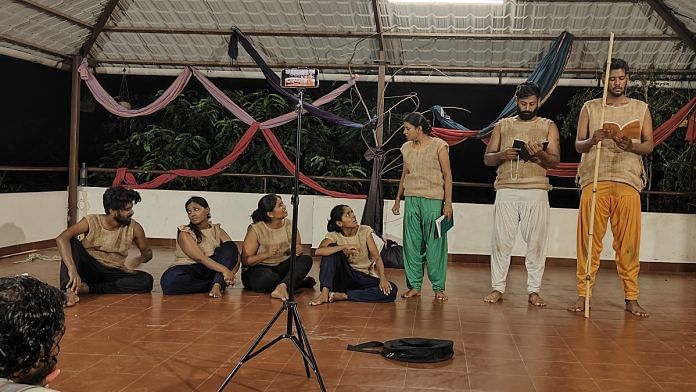Thank you dear subscribers, we are overwhelmed with your response.
Your Turn is a unique section from ThePrint featuring points of view from its subscribers. If you are a subscriber, have a point of view, please send it to us. If not, do subscribe here: https://theprint.in/subscribe/
In a familiar scenario, parents often scare their children during mealtime with warnings of a “Boogeyman”. But who exactly is this Boogeyman? Inspired by the concept of an unseen, looming threat, Samuel Beckett’s renowned play ‘Waiting for Godot 1’ was adapted into Tamil as ‘Eppo Varuvaro‘ (When Will He Come). Translated by S.M.A. Directed by P. Vasanth, the play was recently staged at Art on Terrace in Besant Nagar and Allianz Française in Nungambakkam, Chennai. Additionally, participating in the recent ‘Mixtura Festival’ helped the play gain more attention from the general audience.
The play opens with some characters who are tying a log on their legs warning that “Highness is coming!” This proclamation leads the onstage characters to abandon their tasks and wait for a deity who is believed to come to Earth and fulfill their basic needs. The play begins with two characters, Visuvaiya and Ayyasamy, illustrating how a disease named ‘laziness’ can spread and erode self-reliant thinking faster than any epidemic.
The ensemble cast, including Deepika, Gayathri, Vijayashanthi, Vignesh, Ravi Rahul, Abhinaya, and Nandakumar, effectively portrays the play’s central theme of waiting and anticipation. Ayyasamy, brainwashed by Visuvaiya, symbolizes how laziness can destroy self-centered thinking, and the other characters add depth to this narrative.
In the Tamil version, the barren tree from Beckett’s original is replaced with a Buddha statue under a peepal tree that transforms into a Ganesha statue after the destruction of Jain monks.
The use of the ‘flashback’ technique borrowed from films is particularly exciting. This method, employed to recount past events is visualized in the play with cinematic aesthetics and a matching musical score. The seamless integration of music and narrative reaches a climax with a beautifully timed moment, where the awaited character suddenly appears and halts, showcasing Vasanth’s exceptional directorial skills.
Tamil Nadu has a long history of challenging conservative beliefs, and the play echoes this tradition by posing critical questions in films like, “When did God speak? I don’t mean that temples shouldn’t exist, but that they shouldn’t become dens of evildoers.” The irony is that those who deny the existence of God never demolish temples, while those who worship God and who forces people to worship their religion dare not only kill and rape but also destroy the temple of another religion. The play highlights that God becomes a focal point where all caste and religious oppressions converge.
In our society, we grow up hearing, “If you do wrong, God will punish you.” This belief complicates the criticism of superstitions. The play questions why God does not punish those who commit crimes using his name and highlights the hypocrisy in religious practices.
The play doesn’t differentiate between Hindus, Muslims, and Christians. It shows how large groups of people are manipulated like sheeps by profit-seeking Religion Mafias. Even the Colors of the holy books hint at the religions without explicitly naming them. Through the character Sarvagan, who advocates renouncing God, the play suggests the possibility of uprooting oppressive beliefs.
Sarvagan asks probing questions like “Do you have food? Proper clothes? A place to stay?” and provide them. These questions make the audience think that these Religion mafias never care about the basic needs of their own people except the benefits from them. In a provocative scene, the characters use holy books to reach a high branch, questioning the utility of these books if they don’t meet urgent human needs. By questioning religious practices and highlighting the superstitions embedded in our culture, “Eppo Varuvaaro” challenges the audience to reflect on their beliefs and the true essence of their faith. Also, at the end of the play, it gives a message ‘Nobody will come to save us. We must fight for ourselves’.
In Tamil literature, a character named ‘Sarvagan’ a leprosy doctor’ is well-known. In this play, a Sarvagan-like character serves as a metaphorical doctor needed at every stage to cure the societal ‘leprosy’ of ignorance. If the root is uprooted, the tree will fall on its own, won’t it?
These pieces are being published as they have been received – they have not been edited/fact-checked by ThePrint


